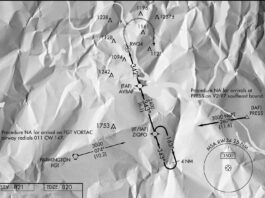The Displaced-Threshold Trap
The pilot of a Baron landing Runway 30R at Bakersfield, Calif., told me this story. The runway is two miles long, but has a 3500-foot displaced threshold.Tower cleared me to land with a Caution wake turbulence behind the departing single-engine Cessna. That didnt sound too bad. As I broke out, I aimed for the standard touchdown point and spotted an airplane ahead.
Why Paranoia is Good for Your Longevity
Three days before Christmas in 1994 a Westwind landed in La Verne, Calif., east of Los Angeles, to drop off the mother of brothers who ran In-and-Out Burgers, a popular fast-food chain in California. They had been on a family trip and had their hunting gear on board. The Westwind took off for John Wayne Airport, a short ride south from La Verne. It crashed on short final to Runway 19R, diving vertically into a parking lot near the airport. It exploded and shot off ammunition in all directions. It had encountered a Boeing 757 wake.
Readback: April 2010
In response to your article What is Minimum Fuel? (Feb 2010 IFR):I believe that the single most important thing to do at your first thought that you may be running tight on fuel is to slow down to your max range power setting-which is about 40-percent power in most small planes-and lean to 50-degrees lean of peak EGT. This will allow you to fly the longest distance with the remaining fuel before you drop from the sky. The distance is what is important, not the time.
Against the Flow
Change is certainly a constant in aviation. Beyond aircraft technological advances, the rules that govern how air traffic control handles those aircraft are also frequently adjusted. One area in particular thats seen significant discussion and change in the past three years is opposite direction operations (ODO). The official Pilot/Controller Glossary defines ODO: Aircraft are operating in opposite directions when: a. They are following the same track in reciprocal directions; or b. Their tracks are parallel and the aircraft are flying in reciprocal directions; or c. Their tracks intersect at an angle of more than 135 degrees.
Readback: February 2015
I read with interest and obvious necessity for possible future application, your article on hypoxia, Get Your Mask On, in December, 2014.I fly a Malibu Mirage PA 46. Ive had several decompressions in the low 20s that were attributed to squat switch/pressure switch failures. Ive now added another immediate action to pressurization problems:
Are You Established?
Debates are a mainstay of hangar-flying discussions. Those debates can become particularly compelling and energized when the weather is below minimums or the wind is sending small structures and the occasional passerby tumbling across the ramp. Youll often hear conflicting statements from different pilots, many even beginning, Well, the examiner on my last checkride said…
Contradictory Departures and Other Stupid Rules
Each pilot must comply with any departure procedures established for that airport by the FAA. Id bet a lunch with the editor of IFR that this excerpt from Part 91.129 (g)was written by some non-flying FAA lawyer. It sounds good by itself, but how do you apply this rule on a day when youre launching IFR but the initial climb is in the clear and in direct violation of the local noise-abatement policy? If you fly the departure, are you in violation? What if you turn for noise, will you get a tongue-lashing from ATC when you check on?
IFR Tip: Dont Stop Climbing
On Nov. 6, 2007, a King Air crashed seconds after a low-visibility takeoff from 26L at Chino, Calif., (KCNO). The NTSBs typically terse probable cause determination of the accident-... the pilots failure to maintain a positive climb rate during an instrument takeoff ...-provides few clues as to what led the 3100-hour commercial pilot to mow the tops of nearby trees on his brief climb-out.
Launching on the Gauges
On a recent IFR flight, climbing through 500 feet, I noticed the tach was low by 300 RPM. It had been normal just moments before when I checked it on the takeoff roll. Just as it really sunk in that something was amiss, Tower called to hand me off to Departure. I declined, asked to land immediately and alerted them to the abnormal condition. The discrepancy didnt reappear on a second run-up, or ever since.
Say More With Less
People are naturally social creatures, eager to converse with their own kind. While friendly chit-chat is great during quality time with the friends and family, when you key up a radio frequency, its time to pare back the language and cut to the chase.
Readback: January 2015
The last question on Octobers Killer Quiz asks at what altitude you must leave the MPV VOR. Youve departed on the ODP, which says to cross MPV at or above 3500 feet before proceeding on course. But, the scenario is that youre entering an ILS 17 feeder route from MPV, and that altitude is 5900 to the IAF at TJAYS. You said its required to cross MPV at 5900 (answer c). I disagree.
All Hands on Deck
The concept of crew resource management (CRM) was born in aviation. Airlines preach its benefits and train their pilots to work as a team. Flying a modern aircraft involves some complex task management, and dividing that workload between multiple people brings increased safety and efficiency.











